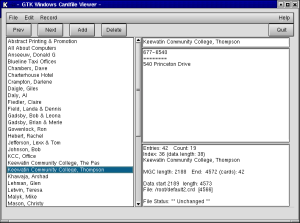 The Cardfile Viewer, empty. |
 The cardfile viewer, with card data. |
| Byte # |
Description |
| 0 - 2 |
Signature bytes ‘MGC’ (4D 47 43) |
| 3 - 4 |
Number of cards in file (maximum 65535) |
Header Format: RRG signature
| Byte # |
Description |
| 0 - 2 |
Signature bytes ‘RRG’ (52 52 47) |
| 3 - 6 |
Last object’s ID |
| 7 - 8 |
Number of cards in file (maximum 65535) |
Index Entry Format: Both signatures
| Byte offset |
Description |
| 0 - 5 |
Null bytes, reserved for future. |
| 6 - 9 |
Absolute position of card data in file (32 bits) |
| 10 |
Flag byte (00) |
| 11-50 |
Index line text, null terminated |
| 51 |
Null byte, indicates end of entry (why?) |
| G & T |
T |
G |
Description |
| 0 - 1 |
0 - 1 |
0 - 1 |
Length of graphic bitmap (lob) |
| 2 - 3 |
2 - 3 |
Width |
|
| 4 - 5 |
4 - 5 |
Height |
|
| 6 - 7 |
6 - 7 |
X-co-ord |
|
| 8 - 9 |
8 - 9 |
Y-co-ord |
|
| 10 - eob |
10 - eob |
Bitmap Graphic |
|
| eob +1 - +2 |
2 - 3 |
eob +1 - +2 |
Length of text entry (lot) |
| eob +3 - end |
4 - lot |
eob +3 - end |
Text data |
| G & T |
T |
G |
Description |
| 0 - 1 |
0 - 1 |
0 - 1 |
object flag - Null if no object |
| 2 - 5 |
2 - 5 |
Unique object ID |
|
| 6 - x |
6 - x |
OLE object |
|
| x+1 - x+2 |
x+1 - x+2 |
DIB character width |
|
| x+3 - x+4 |
x+3 - x+4 |
DIB character height |
|
| x+5 - x+6 |
x+5 - x+6 |
X coordinate U-L |
|
| x+7 - x+8 |
x+7 - x+8 |
Y coordinate U-L |
|
| x+9 - x+10 |
x+9 - x+10 |
X coordinate L-R |
|
| x+11 - x+12 |
x+11 - x+12 |
Y coordinate L-R |
|
| x+13 - x+14 |
x+13 - x+14 |
embedded=0,linked=1, static=2 |
|
| x+15 - x+16 |
2 - 3 |
x+15 - x+16 |
length of text entry |
| x+17 - y |
4 - z |
x+17 - y |
text |